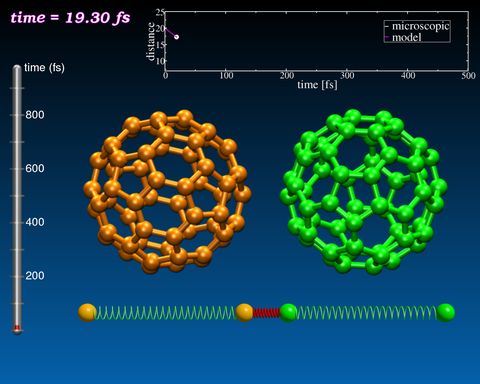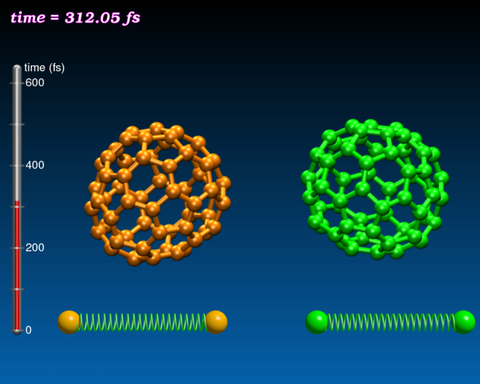Fusion mechanism in C60+C60 collisions
Inhaltsverzeichnis
Fusion dynamics
Movie:
Calculated (NA-QMD) central C60+C60 collision at Ecm=100 eV impact energy.
The fused, highly excited compound C120 is stable and experimentally observed [3].
We have repeated [1,2] our previous QMD-calculations [3], but performed in addition a normal mode analysis of the vibrational excitations during the collision. Surprisingly, an overwhelming dominance of the so-called quadrupole or oblate-prolate mode Hg(1) in the normal mode spectrum has been found.
This motivated us to formulate an analytical two-dimensional collision model:
Two-dimensional classical trajectory model (CTM)
The system is described by two identical springs with the relative center of mass distance R(t) and the spring length D(t). The interaction between the two springs is given by a repulsive harmonic potential in the entrance channel, and an additional "dissipative" potential in the exit channel. The model trajectories R(t) are in excellent agreement with the 360-dimensional NA-QMD calculations for scattering as well as fusion. The fusion barriers for different fullerene - fullerene collisions, predicted by the model, are in excellent agreement with experimental data [1].
Fusion (NA-QMD + CTM)
Movie:
Calculated (NA-QMD) central C60+C60 collision compared with the two-dimensional classical trajectory model at Ecm=100 eV impact energy.
Scattering (NA-QMD + CTM)
Movie:
Calculated (NA-QMD) central C60+C60 collision compared with the two-dimensional classical trajectory model at Ecm=40 eV impact energy.
- J. Handt and R. Schmidt, Fusion mechanism in fullerene-fullerene collisions: The deciding role of giant oblate-prolate motion, Europhysics Letters 109, 63001 (2015).
-
R. Schmidt and J. Handt, Laser- and Collision-Induced Collective Vibrational Excitations in Fullerenes, AIP Conf. Proc. 1197(1), 144-151 (2009).
-
F. Rohmund, E. E. B. Campbell, O. Knospe, G. Seifert, and R. Schmidt, Collision Energy Dependence of Molecular Fusion and Fragmentation in C60+ + C60 Collisions,
Phys. Rev. Lett. 76, 3289 (1996).



